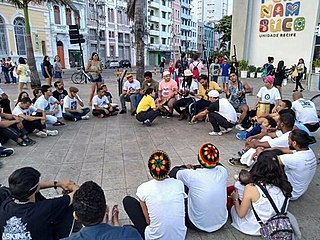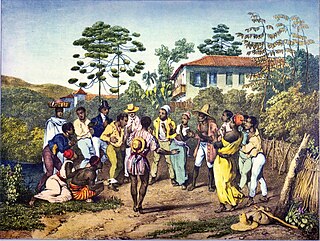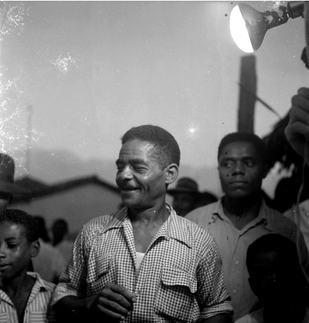
Capoeira is an Afro-Brazilian martial art and game that includes elements of dance, acrobatics, music and spirituality.

The music of Brazil encompasses various regional musical styles influenced by European, American, African and Amerindian forms. Brazilian music developed some unique and original styles such as forró, repente, coco de roda, axé, sertanejo, samba, bossa nova, MPB, gaucho music, pagode, tropicália, choro, maracatu, embolada, frevo, brega, modinha and Brazilian versions of foreign musical styles, such as rock, pop music, soul, hip-hop, disco music, country music, ambient, industrial and psychedelic music, rap, classical music, fado, and gospel.

Samba is a lively dance of Afro-Brazilian origin in 2/4(2 by 4) time danced to samba music.

The berimbau is a traditional Angolan musical bow that is commonly used in Brazil. It is also known as Sekitulege among the Baganda and Busoga.

The atabaque is a tall, wooden, Afro-Brazilian hand drum, similar to conga.

Maculelê is an Afro-Brazilian stick-dance from Bahia.

Manuel dos Reis Machado, commonly called Mestre Bimba, was a Brazilian capoeira mestre and the founder of the capoeira regional style. Bimba was one of the best capoeiristas of his time, undefeated in numerous public challenges against fighters from various martial arts.

Capoeira music is the traditional musical accompaniment used in Afro-Brazilian art capoeira, featuring instruments like berimbau, pandeiro, atabaque, agogô, and reco-reco. The music plays a crucial role in capoeira roda, setting the style the energy of a game.
Batucada is a substyle of samba and refers to a percussive style, usually performed by an ensemble, known as a bateria. Batucada is characterized by its repetitive style and fast pace. Like samba, the batucada is a Brazilian musical expression with African roots.

Capoeira de Angola or simply angola is the traditional style of capoeira, the Afro-Brazilian martial art. A newer style, based on the reform of capoeira Angola, is called regional.
Latin percussion is a family of percussion, membranophone, lamellophone and idiophone instruments used in Latin music.
In the game of capoeira, toques are the rhythms played on the berimbau. Many toques are associated with a specific game, although organizations differ on how to play each toque. Capoeira toques have their roots in African rhythmic music, which was modified and further developed among the slaves of Brazil.
The term afoxé refers to a Carnival group originating from Salvador da Bahia, Brazil in the 1920s, and the music it plays deriving from the Afro-Brazilian Candomblé religion. It came to indicate a musical rhythm, named ijexá derived from the ijexá nation within Candomblé. Cultural performances of the afoxés, typically at Brazilian Carnival, incorporate choreography, song, ritual language and ceremonies deriving from the Candomblé religion. In Brazil, afoxé is generally performed by blocos, afros-groups of mostly black or mulatto musicians who are familiar with African Brazilian music. Afoxés are a cultural and religious entity that preserves a tradition of Afro-Brazilian culture.

The term bateria means “drum kit” in Portuguese and Spanish. In Brazil, the word is also used for a form of Brazilian samba band, the percussion band or rhythm section of a Samba School. It might also mean battery.
Samba-reggae is a music genre from Bahia, Brazil. Samba reggae, as its name suggests, was originally derived as a blend of Brazilian samba with Jamaican reggae as typified by Bob Marley.

Batuque (drumming) was a general term for various Afro-Brazilian practices in the 19th century, including music, dance, combat game and religion.

Os Afro-sambas is a 1966 studio album by Baden Powell and Vinícius de Moraes. The live album is ranked number 29 on Rolling Stone's list of 100 Greatest Brazilian Albums.

Afro-Brazilian culture is the combination of cultural manifestations in Brazil that have suffered some influence from African culture since colonial times until the present day. Most of Africa's culture reached Brazil through the transatlantic slave trade, where it was also influenced by European and indigenous cultures, which means that characteristics of African origin in Brazilian culture are generally mixed with other cultural references.

Waldemar Rodrigues da Paixão, known as Mestre Waldemar, was a Brazilian capoeira mestre and musician from the state of Bahia. He is considered one of the most artistic and skillful capoeira Angola players of his time.













